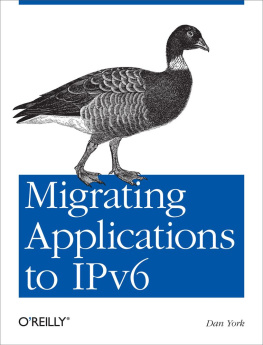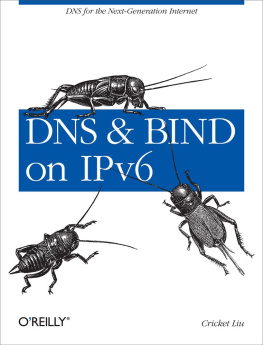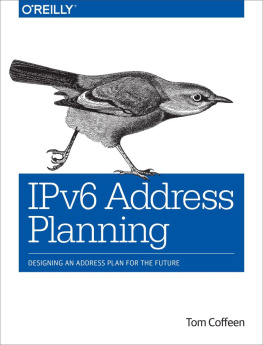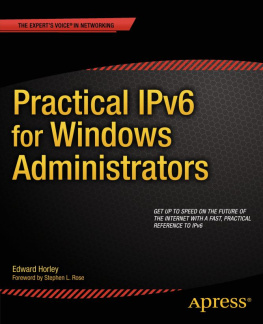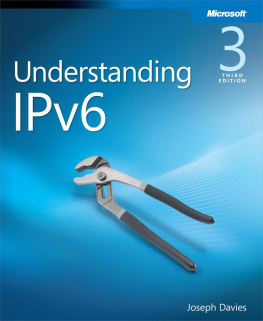Cricket Liu - DNS and BIND on IPv6
Here you can read online Cricket Liu - DNS and BIND on IPv6 full text of the book (entire story) in english for free. Download pdf and epub, get meaning, cover and reviews about this ebook. year: 2011, publisher: OReilly Media, genre: Romance novel. Description of the work, (preface) as well as reviews are available. Best literature library LitArk.com created for fans of good reading and offers a wide selection of genres:
Romance novel
Science fiction
Adventure
Detective
Science
History
Home and family
Prose
Art
Politics
Computer
Non-fiction
Religion
Business
Children
Humor
Choose a favorite category and find really read worthwhile books. Enjoy immersion in the world of imagination, feel the emotions of the characters or learn something new for yourself, make an fascinating discovery.

- Book:DNS and BIND on IPv6
- Author:
- Publisher:OReilly Media
- Genre:
- Year:2011
- Rating:4 / 5
- Favourites:Add to favourites
- Your mark:
- 80
- 1
- 2
- 3
- 4
- 5
DNS and BIND on IPv6: summary, description and annotation
We offer to read an annotation, description, summary or preface (depends on what the author of the book "DNS and BIND on IPv6" wrote himself). If you haven't found the necessary information about the book — write in the comments, we will try to find it.
Cricket Liu: author's other books
Who wrote DNS and BIND on IPv6? Find out the surname, the name of the author of the book and a list of all author's works by series.
DNS and BIND on IPv6 — read online for free the complete book (whole text) full work
Below is the text of the book, divided by pages. System saving the place of the last page read, allows you to conveniently read the book "DNS and BIND on IPv6" online for free, without having to search again every time where you left off. Put a bookmark, and you can go to the page where you finished reading at any time.
Font size:
Interval:
Bookmark:
Copyright 2011 Cricket Liu
OReilly books may be purchased for educational, business, or sales promotional use. Online editions are also available for most titles (.
Nutshell Handbook, the Nutshell Handbook logo, and the OReilly logo are registered trademarks of OReilly Media, Inc. The image of crickets and related trade dress are trademarks of OReilly Media, Inc.
Many of the designations used by manufacturers and sellers to distinguish their products are claimed as trademarks. Where those designations appear in this book, and OReilly Media, Inc., was aware of a trademark claim, the designations have been printed in caps or initial caps.
While every precaution has been taken in the preparation of this book, the publisher and author assume no responsibility for errors or omissions, or for damages resulting from the use of the information contained herein.

Im sorry for writing this ebook.
Well, thats not quite accurate. What I mean is, Im sorry I didnt have time to update DNS and BIND to include all this new IPv6 material. DNS and BIND deserves a sixth edition, but Im afraid my schedule is so hectic right now that I just dont have time to write it. Heck, Im on a flight from Boston to Tampa as I write this. (Long flights are great for writing prefaces, not so great for writing books about Internet technologies. Though in-flight Internet access does help.)
This book is essentially all the material related to IPv6 that I would have included in the sixth edition of DNS and BIND (and will , once I get to it). It covers how DNS was extended to accommodate IPv6 addresses, both for forward-mapping and reverse-mapping. It describes how to configure a BIND name server to run on an IPv6 network and how to troubleshoot problems with IPv6 forward- and reverse-mapping. It even covers DNS64, a DNS-based transition technology that, together with a companion technology called NAT64, can help islands of IPv6-only speaking hosts communicate with IPv4 resources.
I wrote this book for DNS administrators who are rolling out IPv6 on their networks and who need to understand how to support IPv6 on those networks with DNS. This ebook covers the underlying theory, including the structure and representation of IPv6 addresses; the A, M, and O flags in Router Advertisements and what they mean to DNS; as well as the nuts and bolts, including the syntax of AAAA records and PTR records in the ip6.arpa reverse-mapping zone and the syntax and semantics of configuring a BIND name server.
This book assumes that you understand basic DNS theory and BIND configuration. It doesnt explain what a resource record is or how to edit a zone data file, or remind you that you need to increment the serial number of the zones SOA record before reloading it (other than just now)for that, I highly recommend DNS and BIND . But that shouldnt surprise you.
The book doesnt assume that you know anything in particular about IPv6, though.
This book is organized into five chapters as follows:
This chapter explains the motivation behind the move to IPv6 and describes the structure and representation of IPv6 addresses. It also introduces the syntaxes of AAAA records and PTR records in the ip6.arpa IPv6 reverse-mapping zone and explains how to delegate subdomains of ip6.arpa zones.
This chapter describes how to configure BIND name servers to run on IPv6 networks, including how to configure IPv6 master and slave name servers, how to use IPv6 addresses and networks in ACLs, and how to register and delegate to IPv6-speaking name servers. The chapter also includes a section on special considerations that may arise because IPv6 connectivity is not yet pervasive.
This chapter shows how to configure popular stub resolvers (Linux/Unix, Mac OS X and Windows) to query IPv6-speaking name servers. It also covers dynamic configuration of resolvers using DHCPv6 and Router Advertisements.
This chapter explains the DNS64 transition technology, which allows clients with IPv6-only network stacks to communicate with IPv4 servers.
This chapter describes how to use the common nslookup and dig troubleshooting tools to look up the IPv6 addresses of a domain name or reverse-map an IPv6 address to a domain name. It also covers how to query a name servers IPv6 address.
The following typographical conventions are used in this book:
Indicates menu titles, menu options, menu buttons, and keyboard accelerators (such as Alt and Ctrl).
ItalicIndicates new terms, URLs, email addresses, filenames, file extensions, pathnames, directories, and Unix utilities.
Constant widthIndicates commands, options, switches, variables, attributes, keys, functions, types, classes, namespaces, methods, modules, properties, parameters, values, objects, events, event handlers, XML tags, HTML tags, macros, the contents of files, or the output from commands.
Constant width boldShows commands or other text that should be typed literally by the user.
Constant width italicShows text that should be replaced with user-supplied values.
This icon signifies a tip, suggestion, or general note.
This icon indicates a warning or caution.
This book is here to help you get your job done. In general, you may use the code in this book in your programs and documentation. You do not need to contact us for permission unless youre reproducing a significant portion of the code. For example, writing a program that uses several chunks of code from this book does not require permission. Selling or distributing a CD-ROM of examples from OReilly books does require permission. Answering a question by citing this book and quoting example code does not require permission. Incorporating a significant amount of example code from this book into your products documentation does require permission.
We appreciate, but do not require, attribution. An attribution usually includes the title, author, publisher, and ISBN. For example: DNS and BIND on IPv6 by Cricket Liu (OReilly). Copyright 2011 Cricket Liu, 978-1-449-30519-2.
If you feel your use of code examples falls outside fair use or the permission given above, feel free to contact us at .
Safari Books Online is an on-demand digital library that lets you easily search over 7,500 technology and creative reference books and videos to find the answers you need quickly.
With a subscription, you can read any page and watch any video from our library online. Read books on your cell phone and mobile devices. Access new titles before they are available for print, and get exclusive access to manuscripts in development and post feedback for the authors. Copy and paste code samples, organize your favorites, download chapters, bookmark key sections, create notes, print out pages, and benefit from tons of other time-saving features.
OReilly Media has uploaded this book to the Safari Books Online service. To have full digital access to this book and others on similar topics from OReilly and other publishers, sign up for free at http://my.safaribooksonline.com.
Font size:
Interval:
Bookmark:
Similar books «DNS and BIND on IPv6»
Look at similar books to DNS and BIND on IPv6. We have selected literature similar in name and meaning in the hope of providing readers with more options to find new, interesting, not yet read works.
Discussion, reviews of the book DNS and BIND on IPv6 and just readers' own opinions. Leave your comments, write what you think about the work, its meaning or the main characters. Specify what exactly you liked and what you didn't like, and why you think so.

